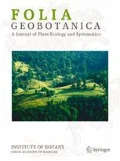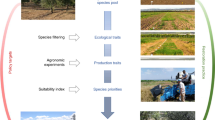Abstract
The restoration of species-rich grasslands is often hindered by high residual soil fertility as a result of, e.g., intensive farming. The establishment of a diverse range of target species on such sites requires the reduction of soil fertility or of the vigour of competitive plants. Current methods to achieve these aims are often unsuccessful or complicated and expensive. It has been suggested thatRhinanthus species could be used to decrease the growth of competitive plants and enhance species diversity. We review evidence for this potential and suggest five key attributes that makeRhinanthus species a practical restoration tool.Rhinanthus species are natural components of species-rich grasslands (attribute 1), and seed of some species is relatively low cost and easily obtainable (2). Recent work has shown that certainRhinanthus species reduce the vigour of competitive species, especially agricultural grasses, and allow establishment and persistence of target species (3). We analyze demographic data and show that certainRhinanthus species have the ability for rapid population growth and spread, even in fertile grasslands (4). We also show that it is relatively easy for land managers to limit the population size ofRhinanthus species and prevent damage (e.g. excessive loss in production or invasion by weeds) to grasslands by excessive densities (5). We give suggestions for further research, including: the range of species-poor grasslands into whichRhinanthus can be introduced successfully and whichRhinanthus species should be used; the mechanisms by whichRhinanthus enhances diversity in restored grasslands; whether the ecotype or subspecies ofRhinanthus used affects restoration success; how management methods affect population growth and spread ofRhinanthus; and whether other parasitic plants could be used in habitat restoration.
Similar content being viewed by others
References
Bullock J.M., Brown V.K., Peel S., Brown R., Everett S., Gray A., Pywell R.F., Smallshire D., McIntyre D., Diaick I. &Mortimer S.R. (2003a): Genetic provenance of seed mixtures for habitat restoration.Bull. Brit. Ecol. Soc. 34: 14–17.
Bullock J.M., Franklin J., Stevenson M.J., Silvertown J., Coulson S.J., Gregory S.J. &Tofts R. (2001): A plant trait analysis of responses to grazing in a long-term experiment.J. Appl. Ecol. 38: 253–267.
Bullock J.M., Moy I.L., Coulson S.J. &Clarke R.T. (2003b): Habitat-specific dispersal: environmental effects on the mechanisms and patterns of seed movement in a grassland herbRhinanthus minor.Ecography 26: 692–704.
Bullock J.M., Moy I.L., Pywell R., Coulson S.J., Nolan A.M. &Caswell H. (2002): Plant dispersal and colonisation processes at local and landscape scales. In:Bullock J.M., Kenward R.E. &Hails R. (eds.),Dispersal ecology, Blackwell Science, Oxford, pp. 279–302.
Callaway R.M. &Pennings S.C. (1998): Impact of a parasitic plant on the zonation of two salt marsh perennials.Oecologia 114: 100–105.
Carruthers W. (1903): Weeds and poisonous plants.J. Roy. Agric. Soc. England 64: 305–309.
Caswell H. (2000):Matrix population models. Sinauer, Sunderland.
Coulson S.J., Bullock J.M., Stevenson M.J. &Pywell R.F. (2001): Colonization of grassland by sown species: dispersal versus microsite limitation in responses to management.J. Appl. Ecol. 38: 204–216.
Davies D.M., Graves J.D., Elias C.O. &Williams P.J. (1997): The impact ofRhinanthus spp. on sward productivity and composition: Implications for the restoration of species-rich grasslands.Biol. Conservation 82: 87–93.
de Hullu E. (1985): The influence of sward density on the population-dynamics ofRhinanthus angustifolius in a grassland succession.Acta Bot. Neerl. 34: 23–32.
de Hullu E., Brouwer T. &ter Borg S.J. (1985): Analysis of the demography ofRhinanthus angustifolius populations.Acta Bot. Neerl. 34: 5–22.
Gibson C.C. &Watkinson A.R. (1989): The host range and selectivity of a parasitic plant —Rhinanthus minor L.Oecologia 78: 401–406.
Gibson C.C. &Watkinson A.R. (1991): Host selectivity and the mediation of competition by the root hemiparasiteRhinanthus minor.Oecologia 86: 81–87.
Gibson C.C. &Watkinson A.R. (1992): The role of the hemiparasitic annualRhinanthus minor in determining grassland community structure.Oecologia 89: 62–68.
Grime J.P. (1979):Plant strategies and vegetation processes. John Wiley and Sons, Chichester.
Joshi J., Matthies D. &Schmid B. (2000): Root hemiparasites and plant diversity in experimental grassland communities.J. Ecol. 88: 634–644.
Magda D., Duru M. &Theau J.P. (2004): Defining management rules for grasslands using weed demographic characteristics.Weed Sci. 52: 339–345.
Marrs R.H. (1993): Soil fertility and nature conservation in Europe — theoretical considerations and practical management solutions.Advances Ecol. Res. 24: 241–300.
Marvier M.A. (1998): Parasite impacts on host communities: Plant parasitism in a California coastal prairie.Ecology 79: 2616–2623.
Matthies D. (1995): Parasitic and competitive interactions between the hemiparasitesRhinanthus serotinus andOdontites rubra and their hostMedicago sativa.J. Ecol. 83: 245–251.
Meek W.M., Loxton R., Sparks T.H., Pywell R.F., Pickett H. &Nowakowski M. (2002): The effect of arable field margin composition on invertebrate biodiversity.Biol. Conservation 106: 259–271.
Mizianty M. (1975): Influence ofRhinanthus serotinus on the productivity and floristic composition of the meadow plant association.Fragm. Florist. Geobot. 21: 491–505.
Mutikainen P., Salonen V., Puustinen S. &Koskela T. (2000): Local adaptation, resistance, and virulence in a hemiparasitic plant-host plant interaction.Evolution 54: 433–440.
Neubert M.G. &Caswell H. (2000): Demography and dispersal: calculation and sensitivity analysis of invasion speed for structured populations.Ecology 81: 1613–1628.
Pennings S.C. &Callaway R.M. (1996): Impact of a parasitic plant on the structure and dynamics of salt marsh vegetation.Ecology 77: 1410–1419.
Press M.C. (1998): Dracula or Robin Hood? A functional role for root hemiparasites in nutrient poor ecosystems.Oikos 82: 609–611.
Preston C.D., Pearman D.A. &Dines T.D. (2002):New atlas of the British and Irish flora. Oxford University Press, Oxford.
Pywell R.F., Bullock J.M., Hopkins A., Walker K.J., Sparks T.H., Burke M.J.W. &Peel S. (2002a): Restoration of species-rich grassland on arable land: assessing the limiting processes using a multi-site experiment.J. Appl. Ecol. 39: 294–309.
Pywell R.F., Bullock J.M., Roy D.B., Warman E.A., Walker K.J. &Rothery P. (2003): Plant traits as predictors of performance in ecological restoration.J. Appl. Ecol. 40: 65–77.
Pywell R.F., Bullock J.M., Walker K.J., Coulson S.J., Gregory S.J. & Stevenson M.J. (2005): Facilitating grassland diversification using the hemiparasitic plantRhinanthus minor. J. Appl. Ecol. (in press).
Pywell R.F., Nowakowski M., Walker K.J. &Barratt D. (1999): A preliminary study of the introduction ofRhinanthus minor into a field margin to control productivity.Aspects Appl. Biol. 54: 315–320.
Pywell R.F., Warman E.A., Bullock J.M., Tallowin J.R.B., Walker K.J., Masters G.J., Smith R.E.N. &Goodyear J. (2002b): Practical techniques to increase the biodiversity of agriculturally improved grasslands. In:Frame J. (eds.),Conservation pays?, British Grassland Society, Reading, pp. 121–124.
Quested H.M., Cornelissen J.H.C., Press M.C., Callaghan T.V., Aerts R., Trosien F., Riemann P., Gwynn-Jones D., Kondratchuk A. &Jonasson S.E. (2003): Decomposition of sub-arctic plants with differing nitrogen economies: A functional role for hemiparasites.Ecology 84: 3209–3221.
Rabotnov T.A. (1959): Vliyanie pogremka (Rhinanthus majorEhrh.) na urozhai i sostav travostoya poimennogo luga (The effect ofRhinanthus majorEhrh. upon the crops and the composition of the floodland herbage).Byull. Moskovsk. Obshch. Isp. Prir. B. Otd. Biol. 64: 105–107.
Rodwell J.S. (1992):British plant communities 3. Grasslands and montane communities. Cambridge University Press, Cambridge.
Seel W.E. &Press M.C. (1996): Effects of repeated parasitism byRhinanthus minor on the growth and photosynthesis of a perennial grass,Poa alpina. New Phytol. 134: 495–502.
Smith R.S., Shiel R.S., Bardgett R.D., Millward D., Corkhill P., Rolph G., Hobbs P.J. &Peacock S. (2003): Soil microbial community, fertility, vegetation and diversity as targets in the restoration management of a meadow grassland.J. Appl. Ecol. 40: 51–64.
Smith R.S., Shiel R.S., Millward D. &Corkhill P. (2000): The interactive effects of management on the productivity and plant community structure of an upland meadow: an 8-year field trial.J. Appl. Ecol. 37: 1029–1043.
Stace C.A. (1997):New flora of the British Isles, Ed. 2. Cambridge University Press, Cambridge.
Stevenson M.J., Bullock J.M. &Ward L.K. (1995): Re-creating semi-natural communities: Effect of sowing rate on establishment of calcareous grassland.Restoration Ecol. 3: 279–289.
Strykstra R.J., Bekker R.M. &Verweij G.L. (1996): Establishment ofRhinanthus angustifolius in a successional hayfield after seed dispersal by mowing machinery.Acta Bot. Neerl. 45: 557–562.
ter Borg S.J. (1985): Population biology and habitat relations of some hemiparasiticScrophulariaceae. In:White J. (eds.),The population structure of vegetation, Junk, Dordrecht, pp. 463–487.
ter Borg S.J. &Bastiaans J.C. (1973): Host-parasite relations inRhinanthus serotinus. I. The effect of growth conditions and host; a preliminary report. In:Proceedings European Weed Research Council Symposium on Parasitic Weeds, Malta University Press, Malta.
Tutin T.G., Heywood V.H., Burges N.A., Valentine D.H., Walters S.M. &Webb D.A. (2001):Flora Europaea 3. Cambridge University Press, Cambridge.
van Hulst R., Shipley B. &Theriault A. (1987): Why isRhinanthus minor (Scrophulariaceae) such a good invader?Canad. J. Bot. 65: 2373–2379.
Waide R.B., Willig M.R., Steiner C.F., Mittelbach G., Gough L., Dodson S.I., Juday G.P. &Parmenter R. (1999): The relationship between productivity and species richness.Annual Rev. Ecol. Syst. 30: 257–300.
Walker K.J., Stevens P.A., Stevens D.P., Mountford J.O., Manchester S.J. &Pywell R.F. (2004): The restoration and re-creation of species-rich lowland grassland on land formerly managed for intensive agriculture in the UK.Biol. Conservation 119: 1–18.
Westbury D. &Dunnett N.P. (2000): The effect of the presence ofRhinanthus minor on the composition and productivity of created swards on ex-arable land.Aspects Appl. Biol. 58: 271–278.
Zopfi H.J. (1993): Ecotypic variation inRhinanthus alectorolophus (Scopoli)Pollich (Scrophulariaceae) in relation to grassland management. I. Morphological delimitations and habitats of seasonal ecotypes.Flora 188: 15–39.
Zopfi H.J. (1995): Life-history variation and infraspecific heterochrony inRhinanthus glacialis (Scrophulariaceae).Pl. Syst. Evol. 198: 209–233.
Author information
Authors and Affiliations
Corresponding author
Rights and permissions
About this article
Cite this article
Bullock, J.M., Pywell, R.F. Rhinanthus: a tool for restoring diverse grassland?. Folia Geobot 40, 273–288 (2005). https://doi.org/10.1007/BF02803240
Received:
Revised:
Accepted:
Issue Date:
DOI: https://doi.org/10.1007/BF02803240




